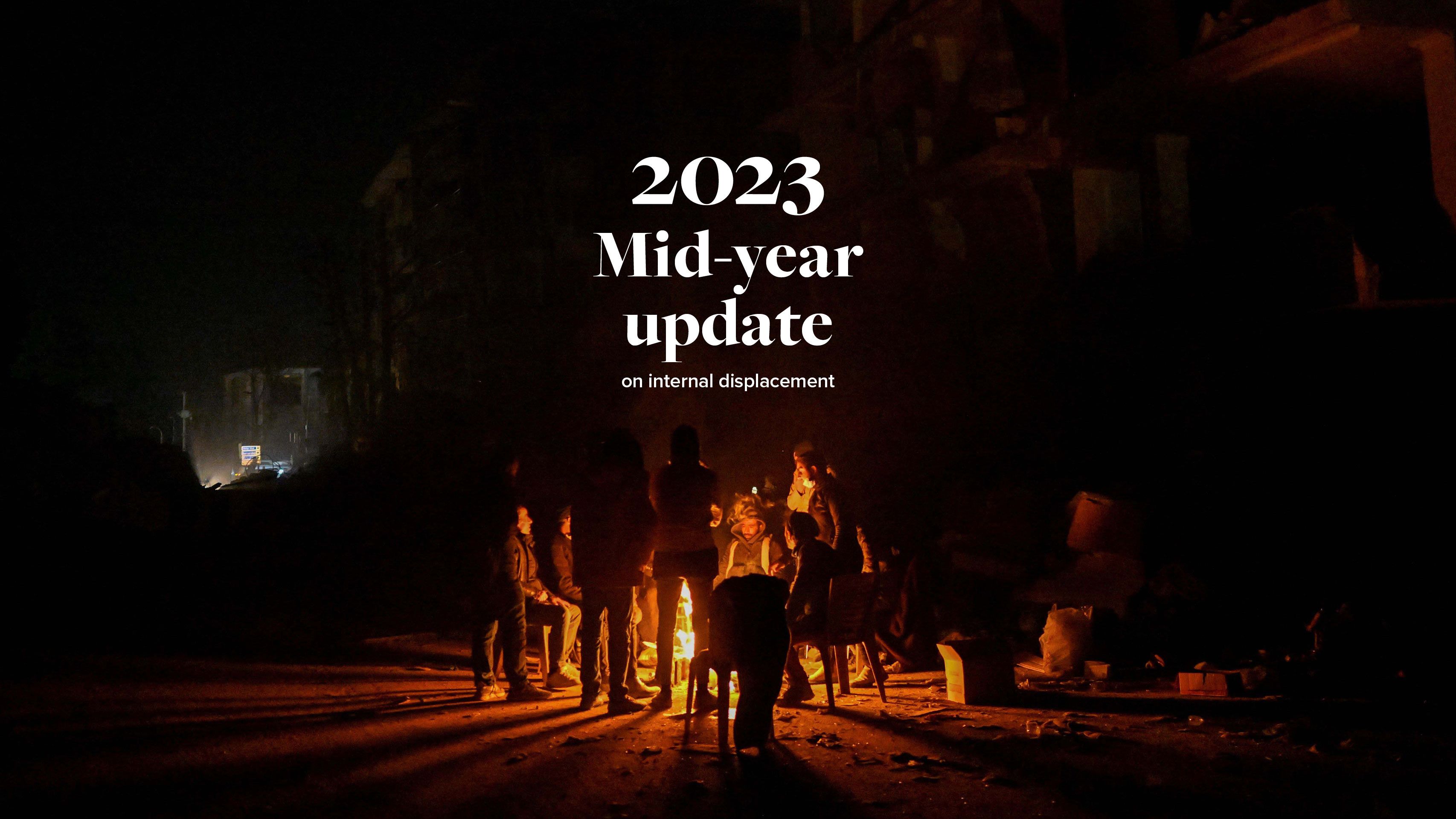
Every day, people flee conflict and disasters and become displaced inside their own countries. The Internal Displacement Monitoring Centre (IDMC), established in 1998 as part of the Norwegian Refugee Council, provides data and analysis and supports partners in identifying and implementing solutions to internal displacement.
Main trends
Conflict and disasters continued to force millions of people to flee their homes in the first half of 2023. Major earthquakes and storms led to record displacements in various countries, while new and ongoing conflict and violence triggered significant new movements in a number of hot spots. Some countries faced a combination of conflict and disaster displacement, further complicating the ability of internally displaced people (IDPs) to achieve solutions.
In this update, we highlight ten of the most notable situations from the first six months of the year, from the scale of disaster displacement in countries such as Türkiye, Syria, Bangladesh and Myanmar to the devastating impacts of conflict and violence in Sudan, Ukraine, Haiti and India.
Each update makes clear the persistent struggle many people face when disasters, conflict or violence force them to flee their homes, and the way their vulnerabilities increase as their displacement becomes prolonged. They also show how reliable and detailed data on displacement helps governments and aid agencies better prepare for and respond to the phenomenon and pursue solutions for the millions who are still uprooted.
We will continue to follow these ten situations and others in the more than 250 countries and territories we monitor around the world. You can see real-time displacement data on our Internal Displacement Updates map and dive deeper into the validated data in our Global Internal Displacement Database. And we will of course provide our annual benchmark in the 2024 Global Report on Internal Displacement, scheduled for publication in May 2024.
Background image: Destroyed apartments in Adana, Türkiye following massive earthquakes in February. © Oguz Yeter/Anadolu Agency/Getty Images
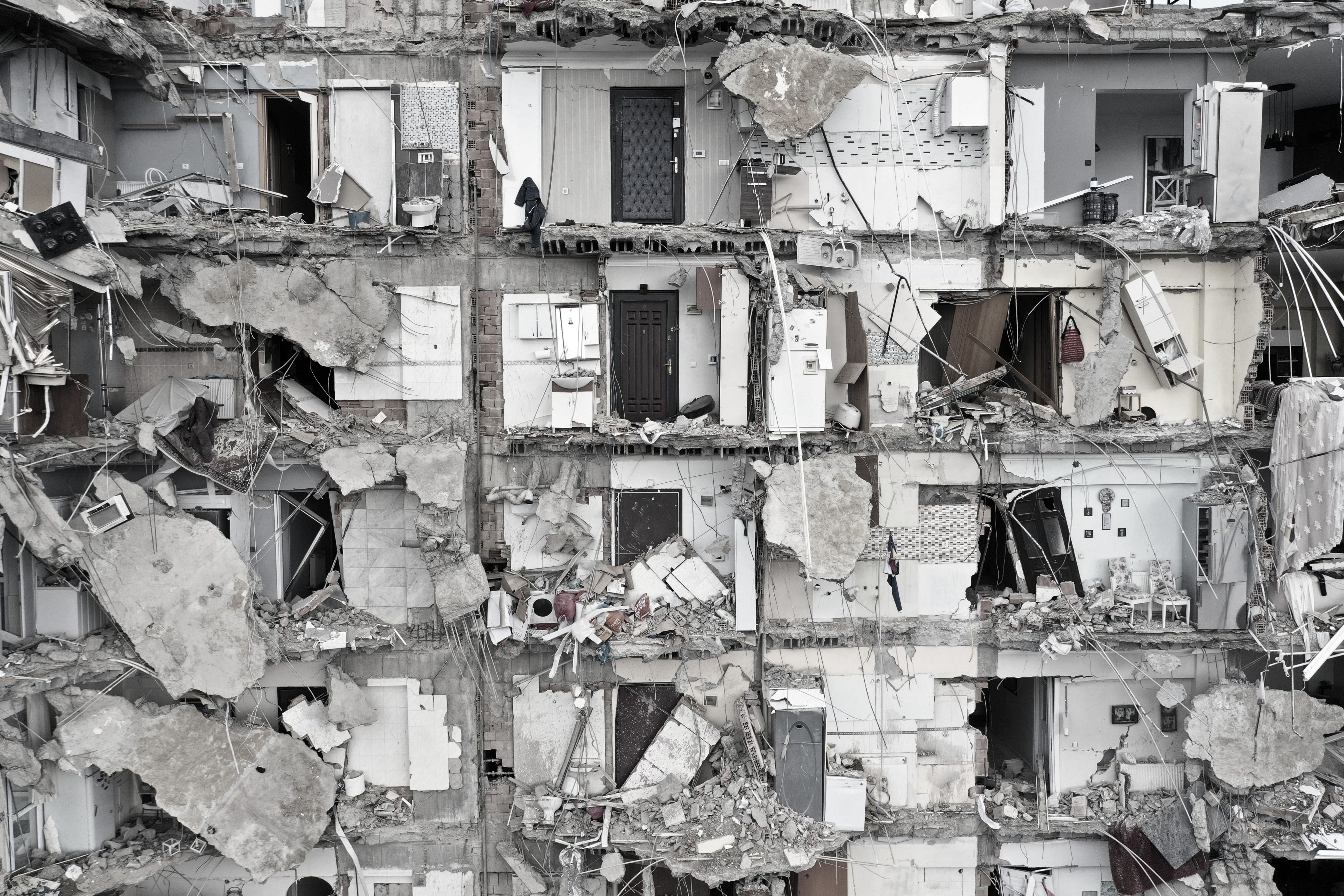
Türkiye: Earthquakes leave millions homeless
Located at the intersection of several tectonic plates, Türkiye is highly prone to earthquakes, and in February 2023 it experienced its worst disaster in recent history. Several earthquakes of magnitudes ranging from 7.8 to 6.3 with epicentres in the provinces of Kahramanmaraş and Hatay caused widespread damage, destruction and displacement in both Türkiye and Syria.1, 2, 3
The earthquakes and subsequent aftershocks triggered around four million internal displacements and killed more than 47,000 people in Türkiye alone. Hundreds of thousands of homes were damaged or destroyed, and many of those still standing had to be demolished. The severity of the quakes, the age of the buildings and the noncompliance of construction standards explain why the destruction was so extensive.4
Damage to health and water infrastructure created health and sanitation challenges for IDPs and other residents, particularly pregnant women, older people and those with chronic diseases. Mental health needs were also high as IDPs struggled with homelessness, the loss of loved ones and post-traumatic stress.5, 6, 7
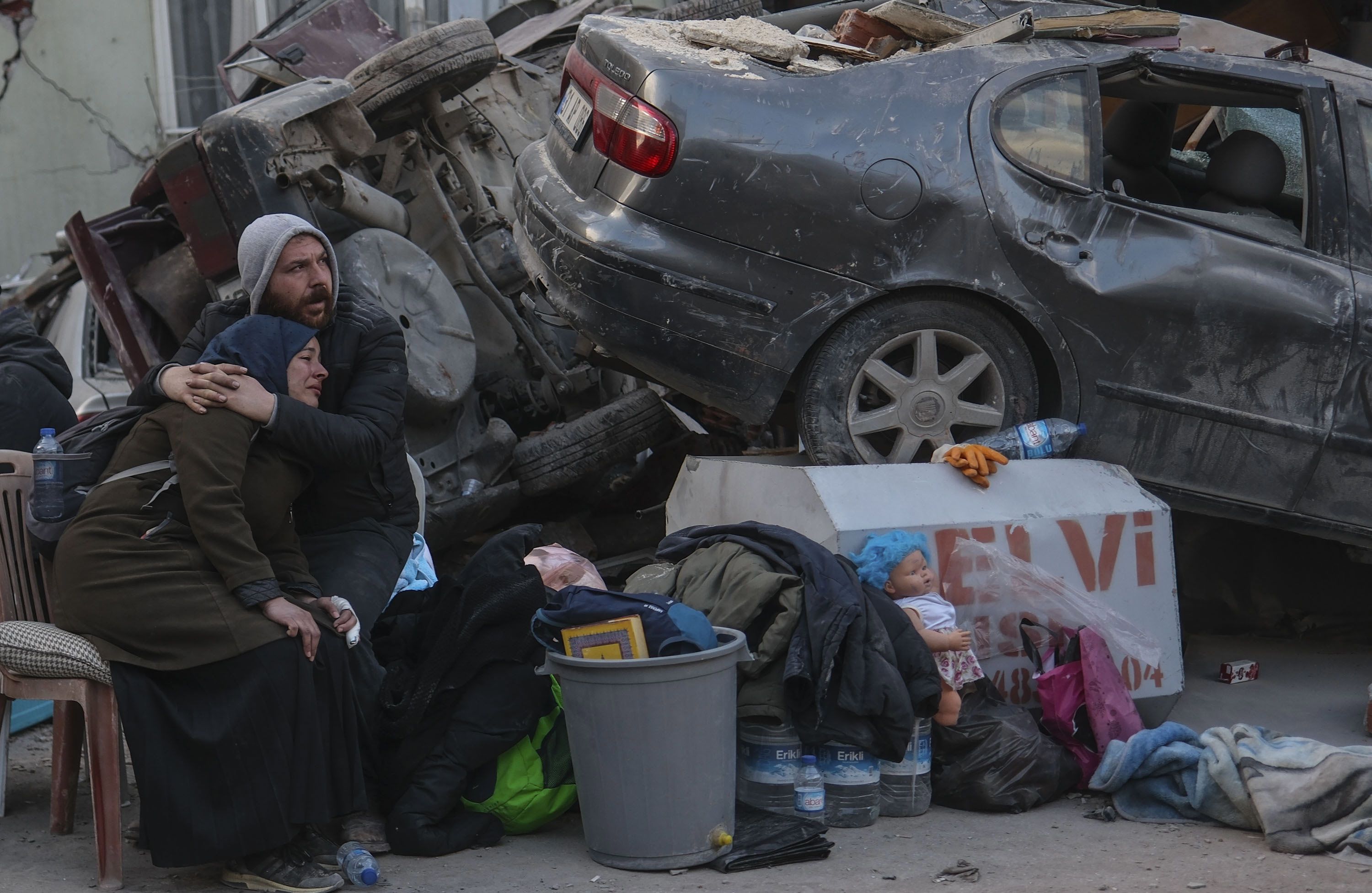
Earthquake survivors awaiting news of their loved ones in Hatay, Türkiye. The earthquakes and their aftershocks triggered around four million internal displacements and killed more than 47,000 people in Türkiye alone. © Ercin Erturk/Anadolu Agency/Getty Images
Earthquake survivors awaiting news of their loved ones in Hatay, Türkiye. The earthquakes and their aftershocks triggered around four million internal displacements and killed more than 47,000 people in Türkiye alone. © Ercin Erturk/Anadolu Agency/Getty Images
The earthquakes also created specific challenges for internally displaced children and young people. Provincial schools incorporated them, but many were overwhelmed by the influx of pupils, putting an additional burden on teachers, many of whom were displaced themselves.8 The areas affected are also home to around 1.8 million Syrian refugees whose needs increased as a result of the disaster.9
More than 271,000 rescue personnel were deployed in the aftermath of the quakes, supported by international emergency teams and nearly 1.4 million Turkish volunteers.10, 11, 12, 13 Hundreds of thousands of tents were set up, and hotels and public buildings were also used to accommodate those forced to flee. Displaced people are gradually moving from tents to container cities that provide them with better living conditions, but emergency shelter is still a priority for many. As of 1 June, four million people were still living in displacement.14
Background image: A collapsed building after the 7.7 magnitude earthquake hit Hatay, Türkiye on 06 February 2023. © Ercin Erturk/Anadolu Agency/Getty Images
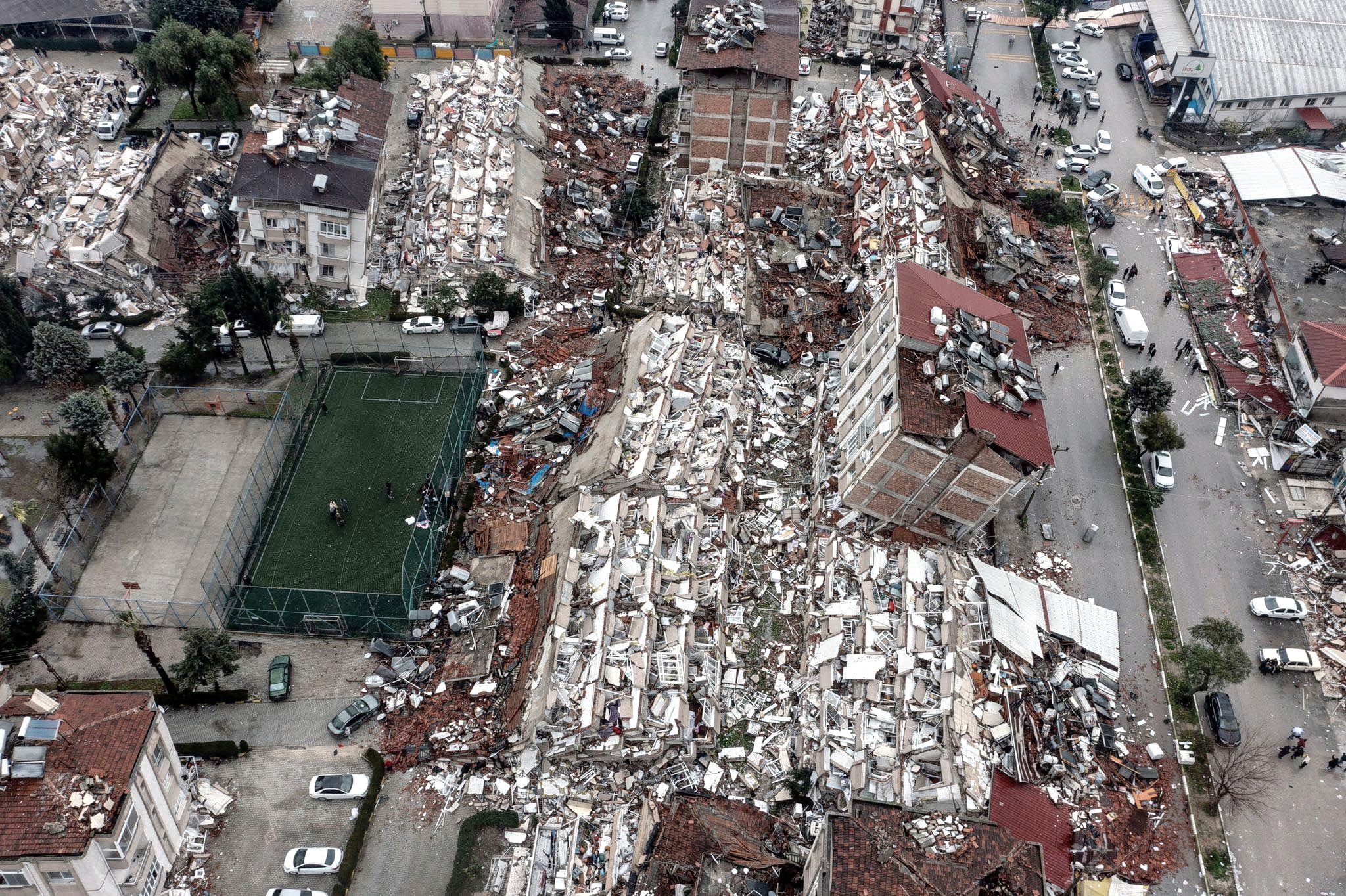
Syria: Earthquakes and conflict combine to
aggravate IDPs’ plight
The February earthquakes in Türkiye triggered more than 677,000 internal displacements in neighbouring Syria, the largest disaster displacement event recorded for the country since data became available in 2014. Idlib and Aleppo governorates, which between them were hosting almost half of the 6.8 million IDPs by the country’s conflict as of May 2022, were hardest hit. The quakes heightened the vulnerabilities of many IDPs who are forced to move each winter as snowstorms and floods hit their shelters.15, 16, 17, 18
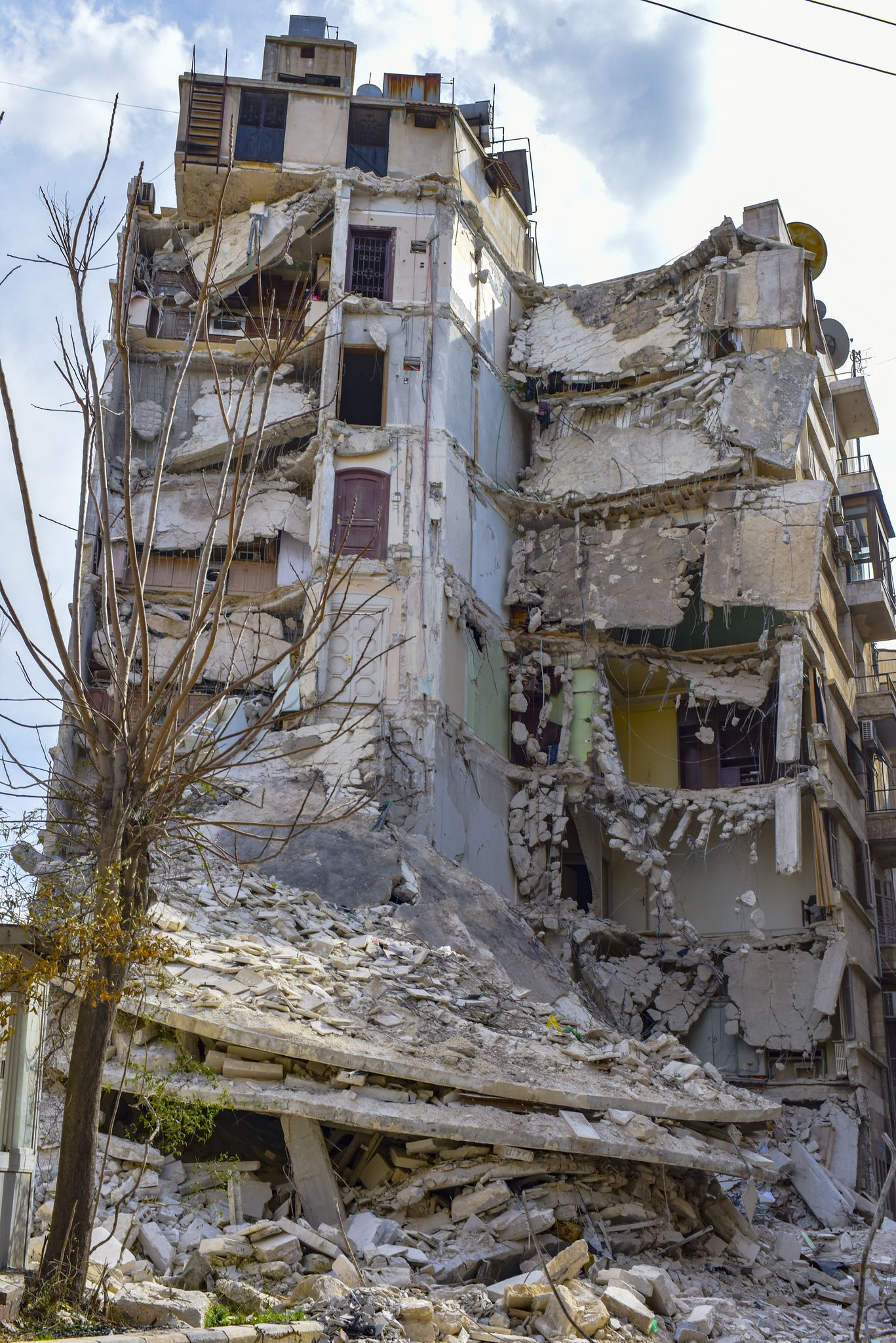
An apartment building in Aleppo razed by the February earthquakes. The quake triggered a record number of disaster displacements in Syria and further complicated living situations for many of the millions of IDPs already displaced by conflict in the country. © NRC/Tareq Mnadili
An apartment building in Aleppo razed by the February earthquakes. The quake triggered a record number of disaster displacements in Syria and further complicated living situations for many of the millions of IDPs already displaced by conflict in the country. © NRC/Tareq Mnadili
As many as 90 per cent of those seeking refuge in the 109 additional emergency camps set up after the earthquakes had already fled conflict.19, 20 Given that many IDPs lived in makeshift settlements, their homes were severely damaged.21 Subsequent snowfall, storms and floods further impeded recovery and led to another 5,800 movements.22, 23
The number of displacements attributed to the quakes is conservative, given constraints on humanitarian access and data collection, particularly in the north-west of the country.24, 25 The situation, however, continues to reveal that when conflict and disasters combine, they prolong displacement and make it more complicated to resolve.
Background image: A woman and children at a shelter for displaced people in Aleppo, Syria. As many as 90 per cent of those seeking refuge in the 109 additional emergency camps set up after the earthquakes had already fled conflict. © NRC/Tareq Mnadili
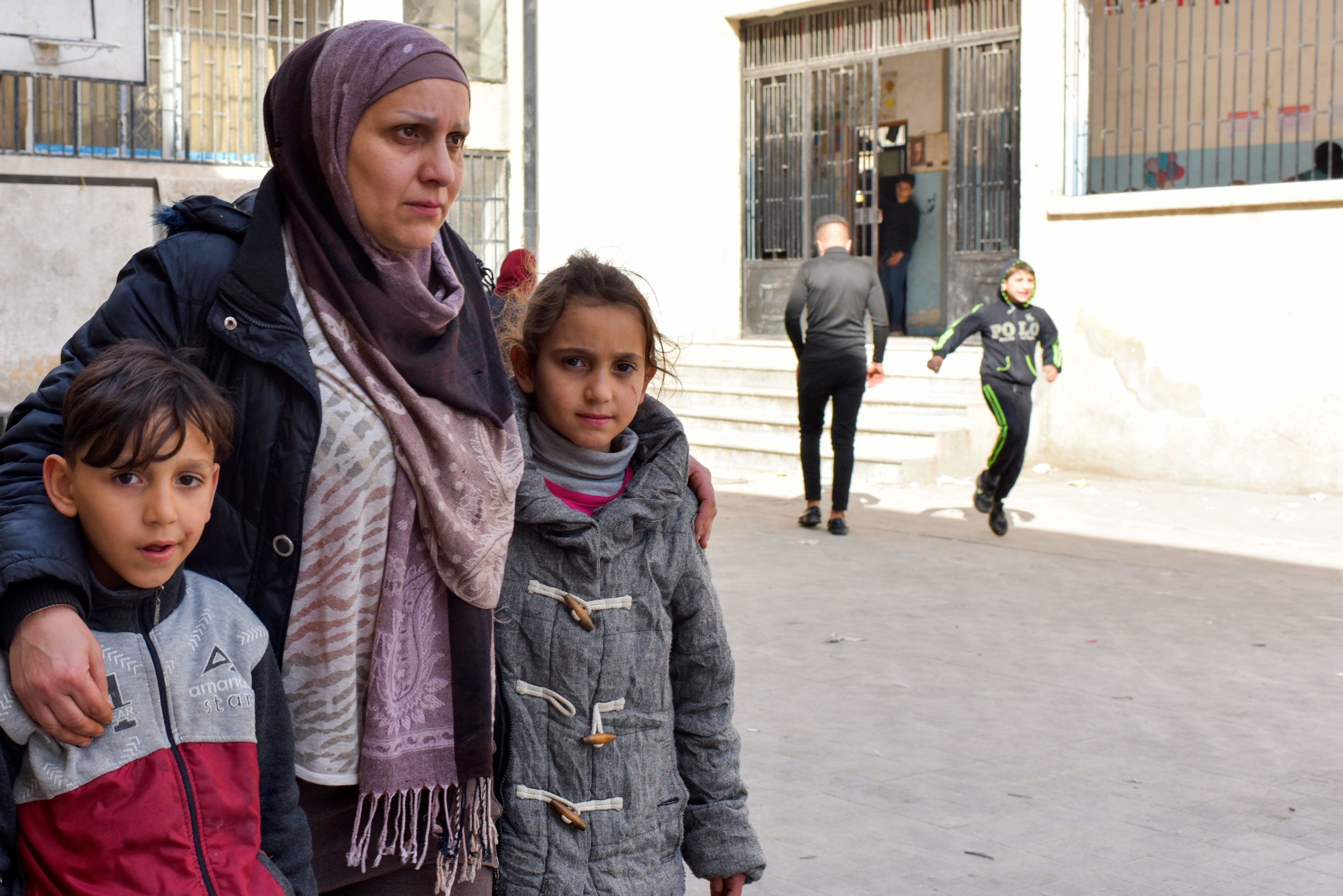
Sudan: Ten years of conflict displacement
in as many weeks
The conflict between the Sudanese armed forces and the paramilitary Rapid Support Forces, which broke out on 15 April, triggered more than 2.2 million internal displacements in its first ten weeks, almost as many as the country recorded in the previous ten years combined.26, 27, 28, 29, 30
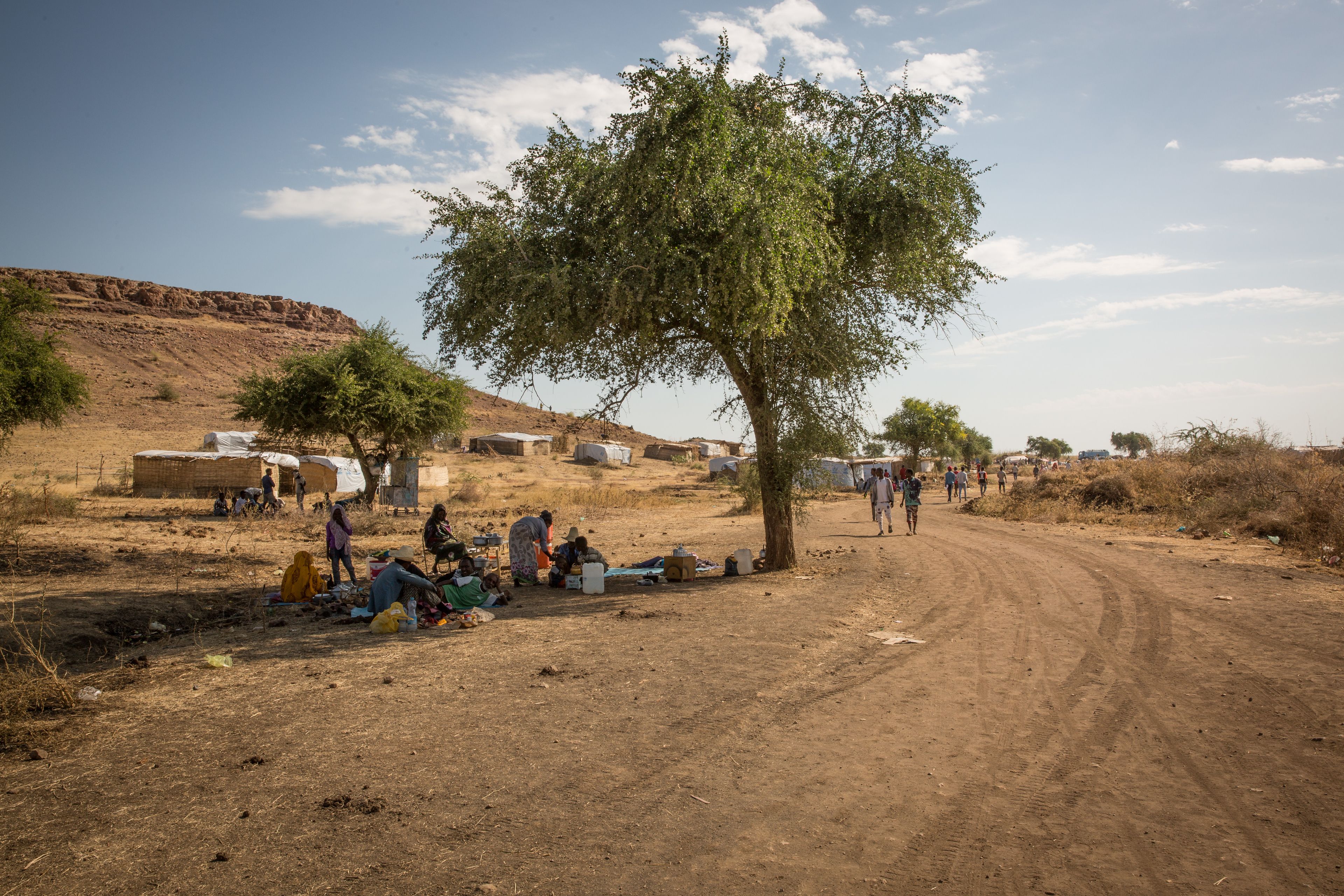
An internally displaced family sets up residence in the shade of a tree in Um Rakuba camp, Sudan. Fighting between the Sudanese armed forces and the paramilitary Rapid Support Forces triggered more than 2.2 million displacements in the first ten weeks of conflict. © Ingebjørg Kårstad/NRC
An internally displaced family sets up residence in the shade of a tree in Um Rakuba camp, Sudan. Fighting between the Sudanese armed forces and the paramilitary Rapid Support Forces triggered more than 2.2 million displacements in the first ten weeks of conflict. © Ingebjørg Kårstad/NRC
More than two-thirds of the movements originated in the capital state of Khartoum, where the heaviest fighting has taken place.31, 32, 33 Clashes also spread to the historically marginalised region of Darfur, which was home to almost three-quarters of the country’s IDPs before the current conflict erupted.34, 35, 36 Many were forced to flee again as a result.37
Years of conflict and violence had already left 3.8 million people, or a tenth of the country’s population, living in internal displacement as of March 2023.38 As women and girls flee the violence both within and beyond the country’s borders, they become more vulnerable to gender-based violence (GBV), including sexual exploitation and domestic abuse.39, 40 In a country where 40 per cent of the population is under 15 years old, the safety of children is also in jeopardy because some families have been separated as a result of their displacement.41, 42
Despite occasional ceasefires, the fighting has severely restricted humanitarian access. Transport, telecommunications and other critical infrastructure has been damaged or destroyed and aid workers have been killed and injured.43 Emergency camps have been set up, but they only host a quarter of the country’s IDPs. The rest have sought shelter with host families.44
Not only have Sudanese nationals fled across borders into neighbouring countries, particularly Egypt and Chad. The conflict has also forced hundreds of thousands of refugees from countries such as Ethiopia, the Central African Republic and South Sudan to go back to their countries of origin, where many have few resources to pursue durable solutions.45, 46, 47, 48
Background image: A great-grandmother in a former office building in Geneina, Sudan, where she is residing after being displaced for a second time by violence. © Rawan Kara/ NRC
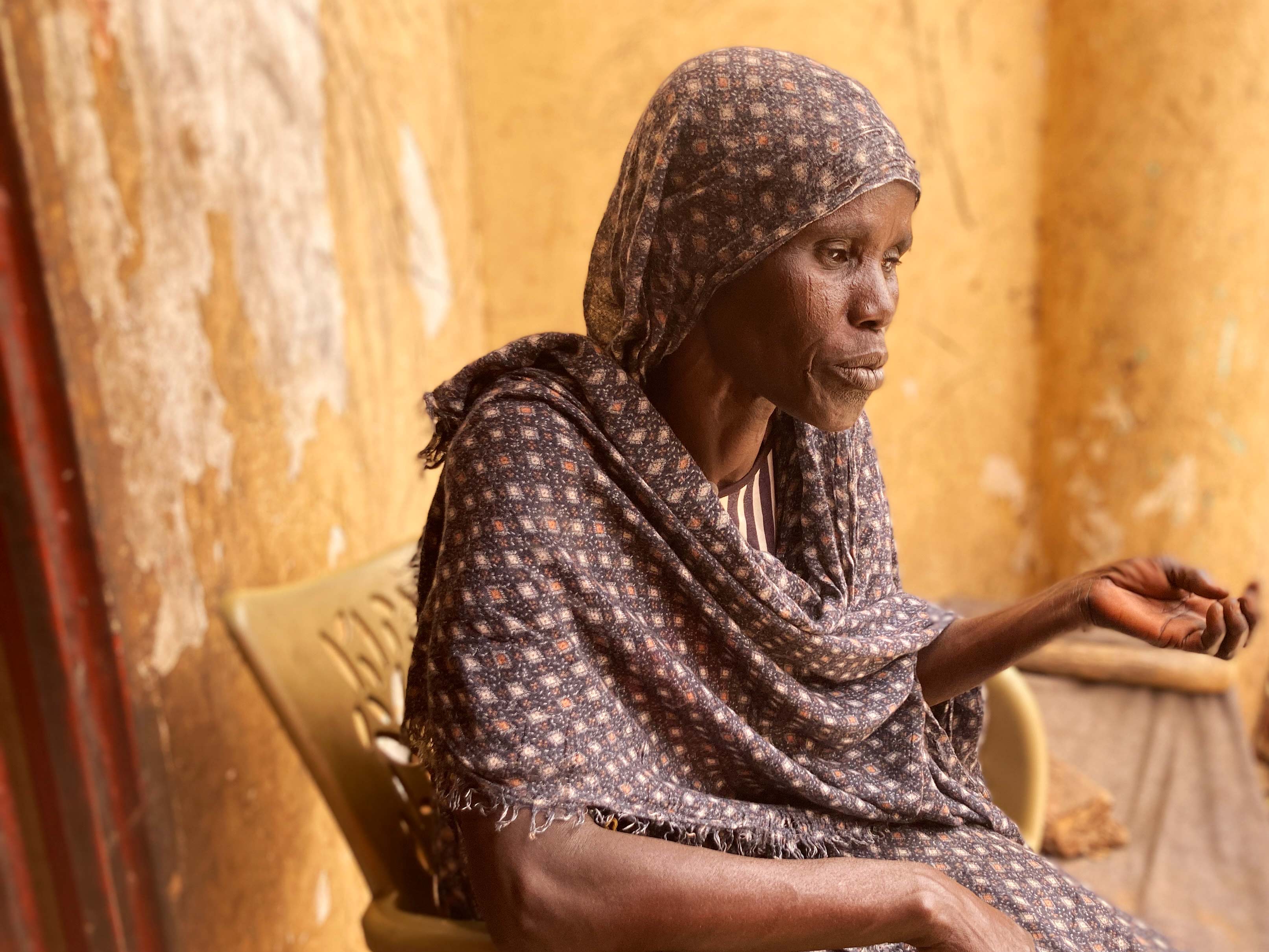
Ukraine: Prolonged displacement is the norm
as conflict persists
As the war in Ukraine continues, durable solutions are a distant prospect for many of the country’s IDPs, who numbered around 5.1 million as of the end of May.49 Intense fighting persists, particularly in the east of the country, and the impacts of the conflict continue to disrupt livelihood opportunities for displaced and non-displaced populations alike.50, 51 Insecurity is also hampering data collection in the occupied territories, making overall displacement estimates conservative.
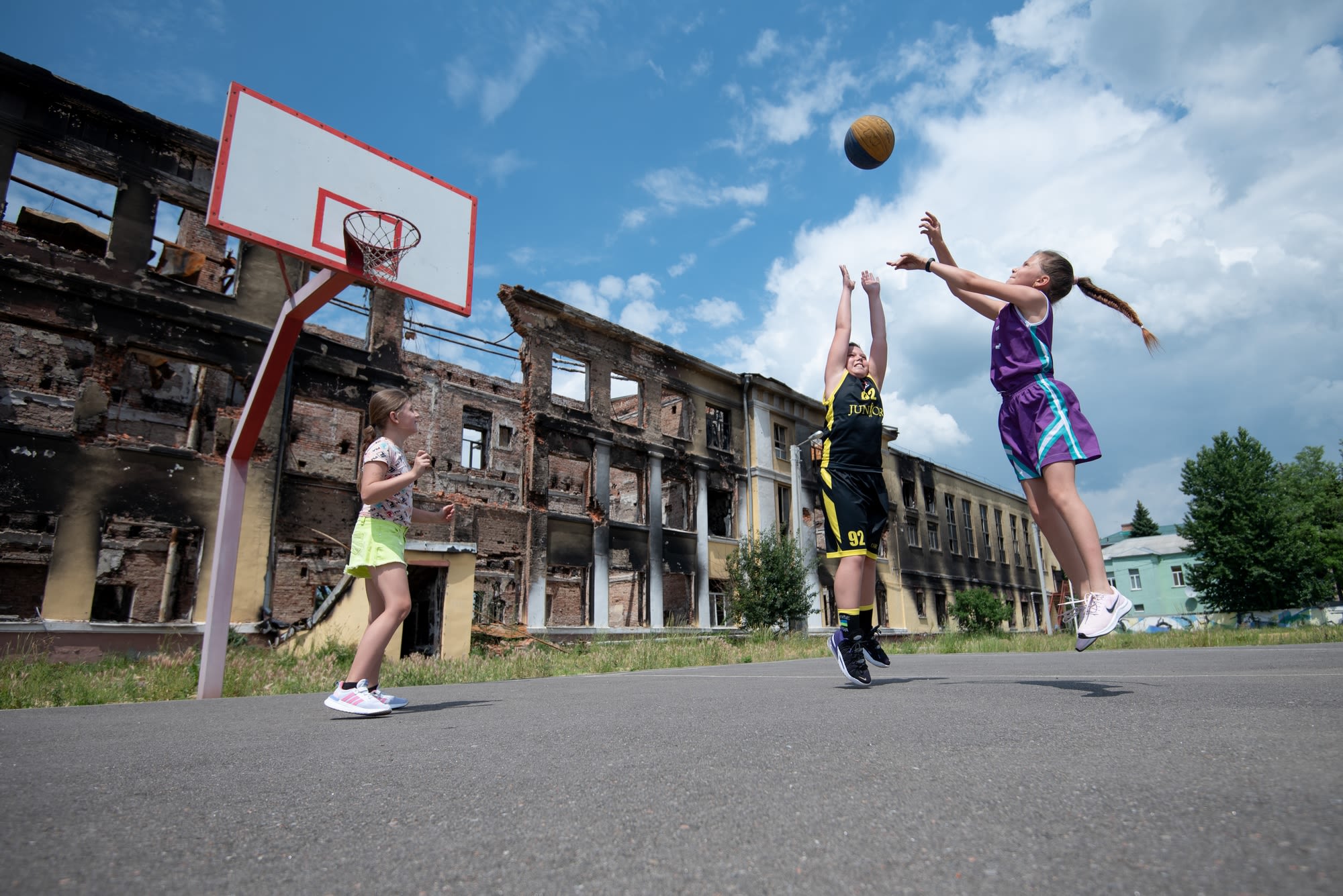
Children play basketball in Kharkiv, Ukraine restored after the court and adjacent school were destroyed by shelling. Continued fighting is creating challenges for the more than 5.1 million IDPs in their efforts to find durable solutions. © UNICEF/UN0668665/Synelnykov
Children play basketball in Kharkiv, Ukraine restored after the court and adjacent school were destroyed by shelling. Continued fighting is creating challenges for the more than 5.1 million IDPs in their efforts to find durable solutions. © UNICEF/UN0668665/Synelnykov
The majority of IDPs have moved from and within the oblasts of Kharkiv, Donetsk and Zaporizhzhia.52 Two-thirds of those surveyed in May and June still cited return as their preferred long-term solution, but the proportion has decreased as the conflict endures, leaving more and more respondents uncertain of their long-term intentions. Others, mostly in urban areas, are increasingly open to integrating locally, but say they need cash assistance, livelihood support and affordable housing to be able to do so.53
Despite numerous cash and social assistance programmes from both the government and non-governmental organisations, IDPs continue to report greater needs across all indicators compared with their non-displaced counterparts. This is particularly the case for displaced women. Sixty per cent of IDPs have been displaced for more than a year, meaning many have exhausted their savings. A quarter rely on their state allowance as their primary source of income.54
The destruction on 6 June of the Kakhovka dam, upstream of the city of Kherson on the Dnipro river, added another layer of complexity to the situation in the frontline area.55 It led to extensive flooding, destroying homes and triggering 12,000 evacuations.56, 57 The floods also threatened to move mines and other explosive ordnance to areas previously uncontaminated, raised concerns about the safety of the nearby Zaporizhzhia nuclear power plant, and damaged water infrastructure, increasing health risks and disrupting agricultural activities and broader food systems.58, 59, 60
Background image: A woman examines the debris of her apartment in Mala Rohan, Ukraine after a Russian shell destroyed it, forcing her to move into an apartment with her neighbours. © UNOCHA/Mateo Minasi
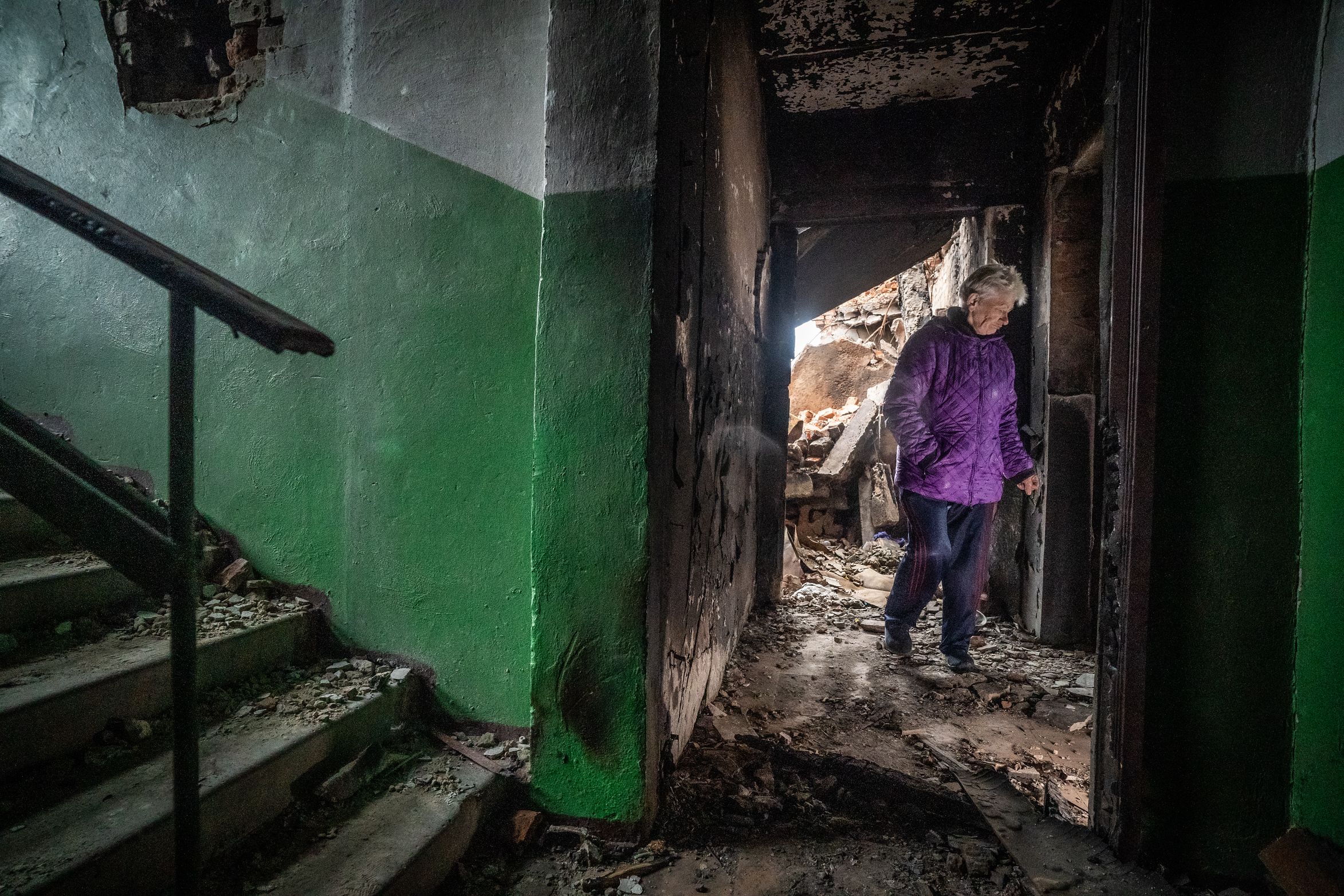
Myanmar and Bangladesh: Cyclone Mocha hits
displaced communities
Tropical cyclone Mocha was the most significant weather-related disaster displacement event globally in the first half of 2023, triggering around 1.7 million movements from Sri Lanka to Myanmar through India and Bangladesh. Myanmar, where Mocha made landfall as a category 4-equivalent cyclone on 14 May, accounted for 912,000. It struck Sittwe, the capital of Rakhine, and caused significant damage to homes across the state. At least 63,000 displacements took place from camps sheltering people already displaced by conflict.
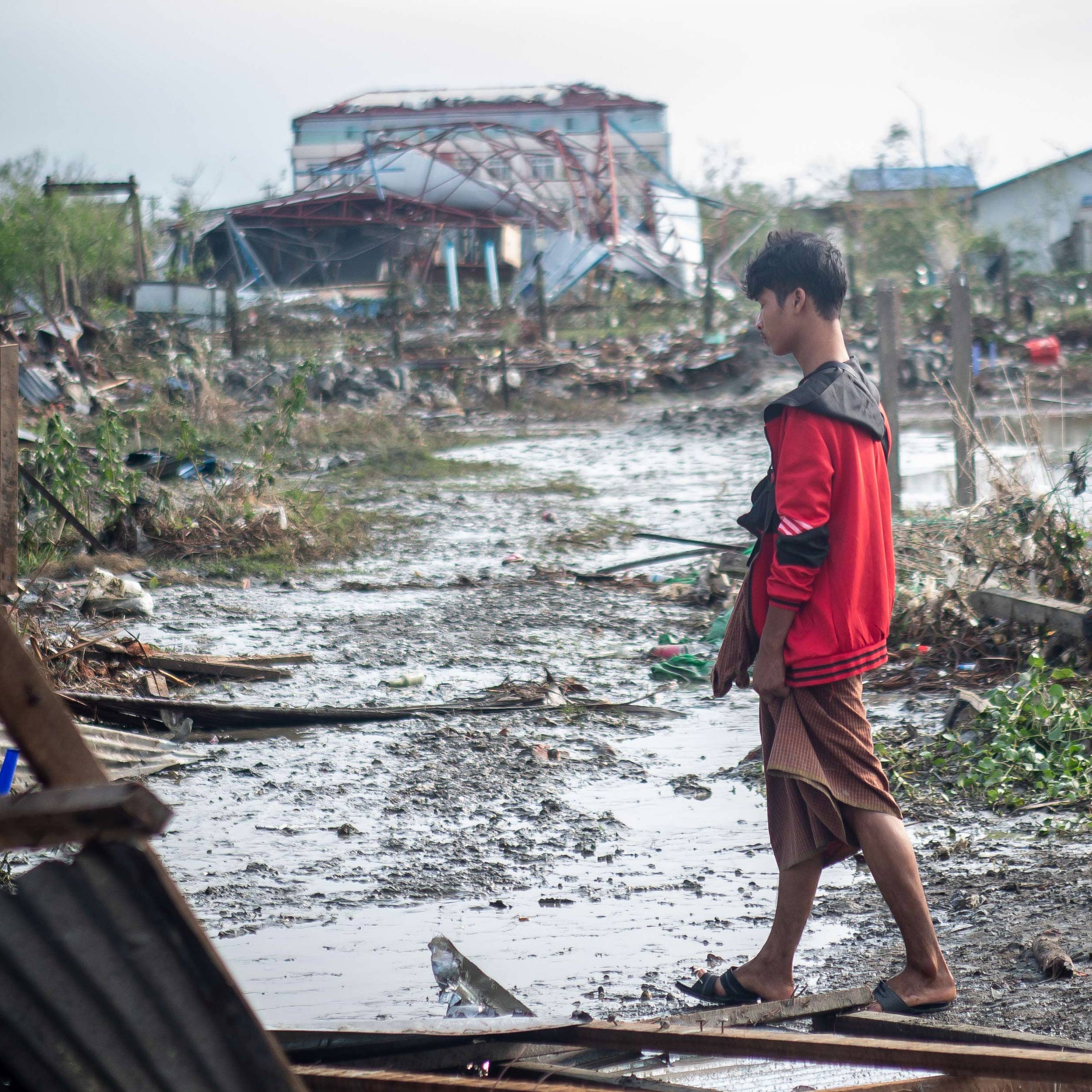
A boy walks through the damage left by Cyclone Mocha in Sittwe, Myanmar. © UNICEF/UN0843641/NaingLinnSoe
A boy walks through the damage left by Cyclone Mocha in Sittwe, Myanmar. © UNICEF/UN0843641/NaingLinnSoe
In Bangladesh, Mocha triggered 780,000 pre-emptive evacuations. A week before its landfall, emergency procedures were put in place in areas at imminent risk, helping to keep casualty figures low and facilitating quick returns.61, 62, 63 The whole population of the island of St Martin was evacuated and boats pulled ashore to avert deaths, losses and damage to livelihoods, attesting the value of lessons learned from previous cyclones in the Bay of Bengal.64, 65
Displacement was reported in Cox’s Bazar, which is home to Rohingya refugees from Myanmar.66 More than 29,000 were temporarily relocated from their homes for up to 12 hours.67 Many of those displaced, however, were living in informal shelters made of materials unable to withstand Mocha’s impacts, which impeded their return and recovery.68, 69, 70
As of the end of June, 13,000 people were still living in internal displacement in Bangladesh pending the reconstruction of their homes. On both sides of the border, Mocha aggravated the humanitarian needs of those already displaced, who continue to face obstacles to their recovery. In Myanmar, this is partly as a result of access restrictions.70
Background image: Residents of a refugee camp in Cox’s Bazar, Bangladesh in the rains preceding Cyclone Mocha. Pre-emptive evacuations helped keep casualty numbers low and facilitated quick returns in the country, although damage to the informal shelters in camps impeded the recovery for their residents. © UNICEF/UN0842307/Mukut
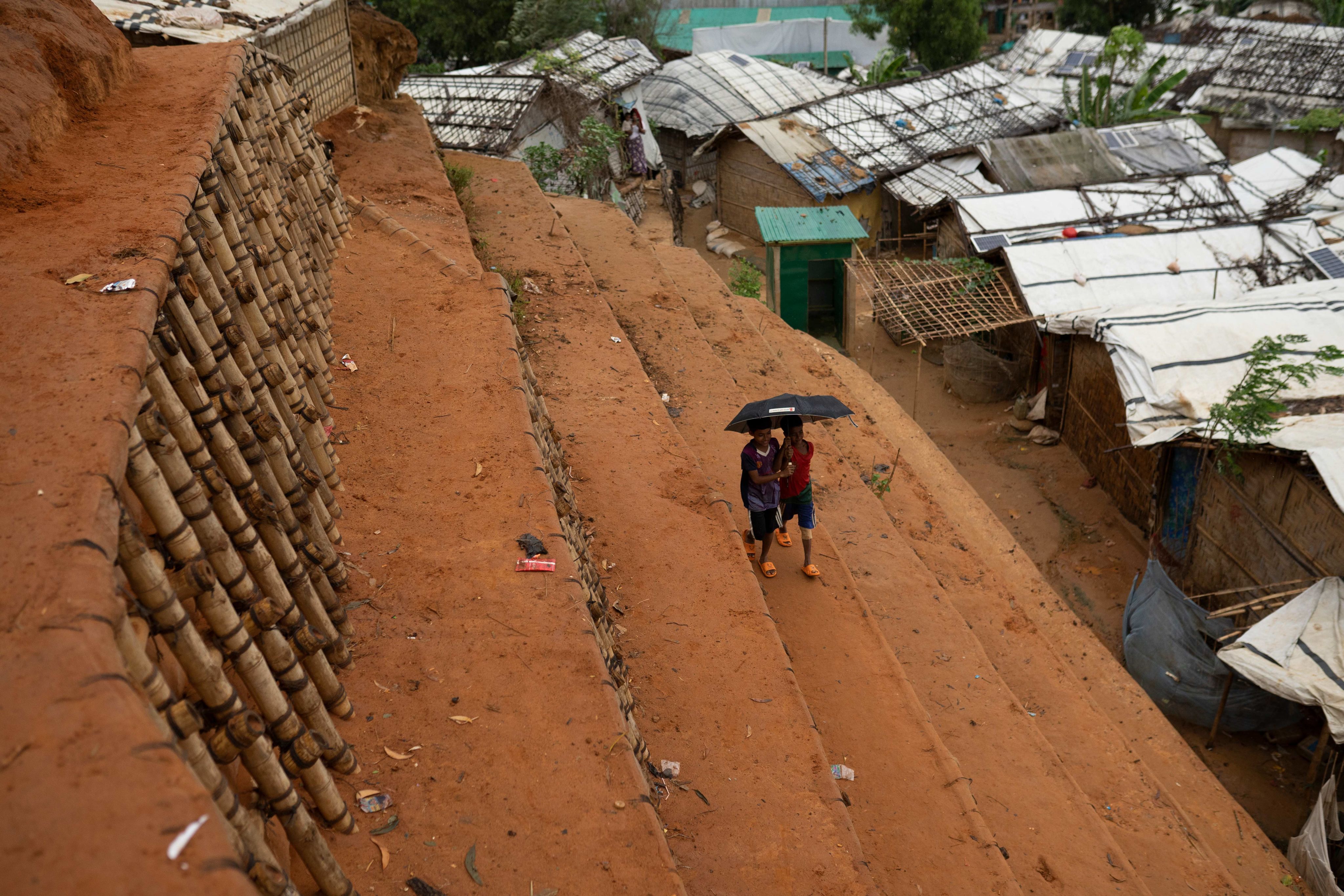
Somalia: Where drought, floods and conflict collide
Conflict and disasters continued to trigger internal displacement in Somalia, with nearly 1.3 million movements recorded in the first half of the year. Conflict and violence accounted for nearly 541,000, and disasters, primarily drought and floods, 715,000.
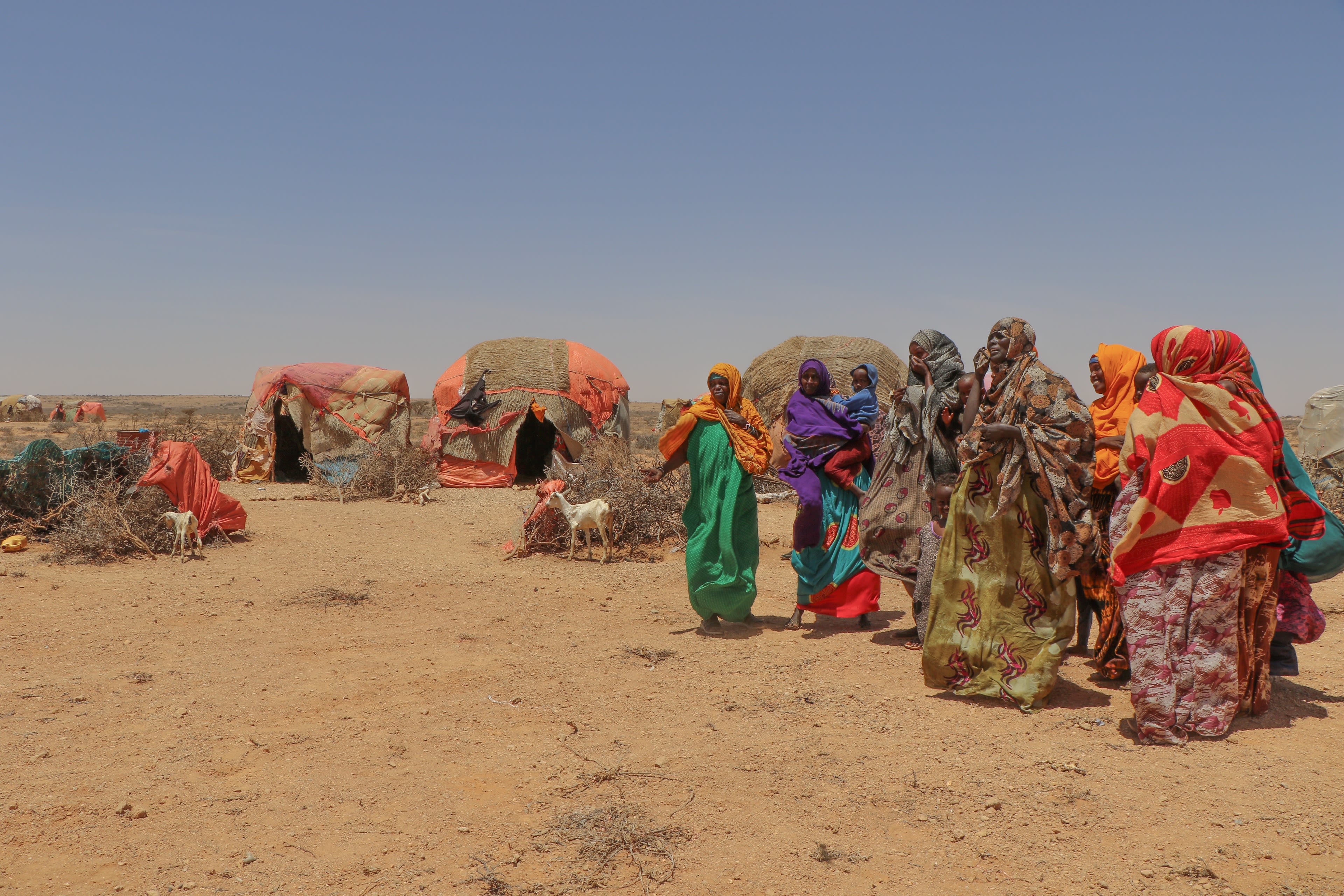
Women outside temporary shelters in Balibusle IDP camp, Somalia. Flooding, drought and conflict led to nearly 1.3 million displacements in the country in the first six months of 2023. © Abdulkadir Mohamed/NRC
Women outside temporary shelters in Balibusle IDP camp, Somalia. Flooding, drought and conflict led to nearly 1.3 million displacements in the country in the first six months of 2023. © Abdulkadir Mohamed/NRC
More than a third of the conflict displacements took place in the northern region of Sool, where fighting around administrative borders erupted in the first quarter of the year in the capital of Las Anod.71, 72, 73 Most people have fled violence by taking refuge in rural areas and with host families.74 In the region of Hiiraan, where most conflict displacements were reported in 2022, the number of movements decreased in the first half of 2023 as local power dynamics shifted and a government-led military campaign made gains against the Al-Shabaab non-state armed group.75, 76
Hiiraan was, however, hit by devastating floods, accounting for 62 per cent of the nearly 418,000 flood displacements reported across the country in the first half of the year. Most of the 260,000 movements recorded took place in May in the Belet Weyne district, where damage to homes in flood-prone areas regularly leads to displacement.77 The floods were a direct consequence of the Shabelle river bursting its banks, but more broadly they were the result of increased precipitation during the Gu rainy season, the onset of the El Niño phenomenon and reduced soil absorption caused by years of drought.78
The rains provided temporary relief to communities affected by drought, but the impacts of the country’s worst in 40 years are far from over. Drought alone triggered 297,000 movements in the first half of 2023, more than 40 per cent of all disaster displacements recorded. People fled in search of food and assistance, mostly in the southern regions of Bay, Gedo and Lower Shabelle.79, 80, 81
Background image: Residents at the Hanano 2 IDP zone in Baidoa, Somalia collect water from a water distribution site set up by the Norwegian Refugee Council. Drought caused more than 40% of the disaster displacements recorded in the country in the first half of 2023. © Abdulkadir Mohamed/NRC
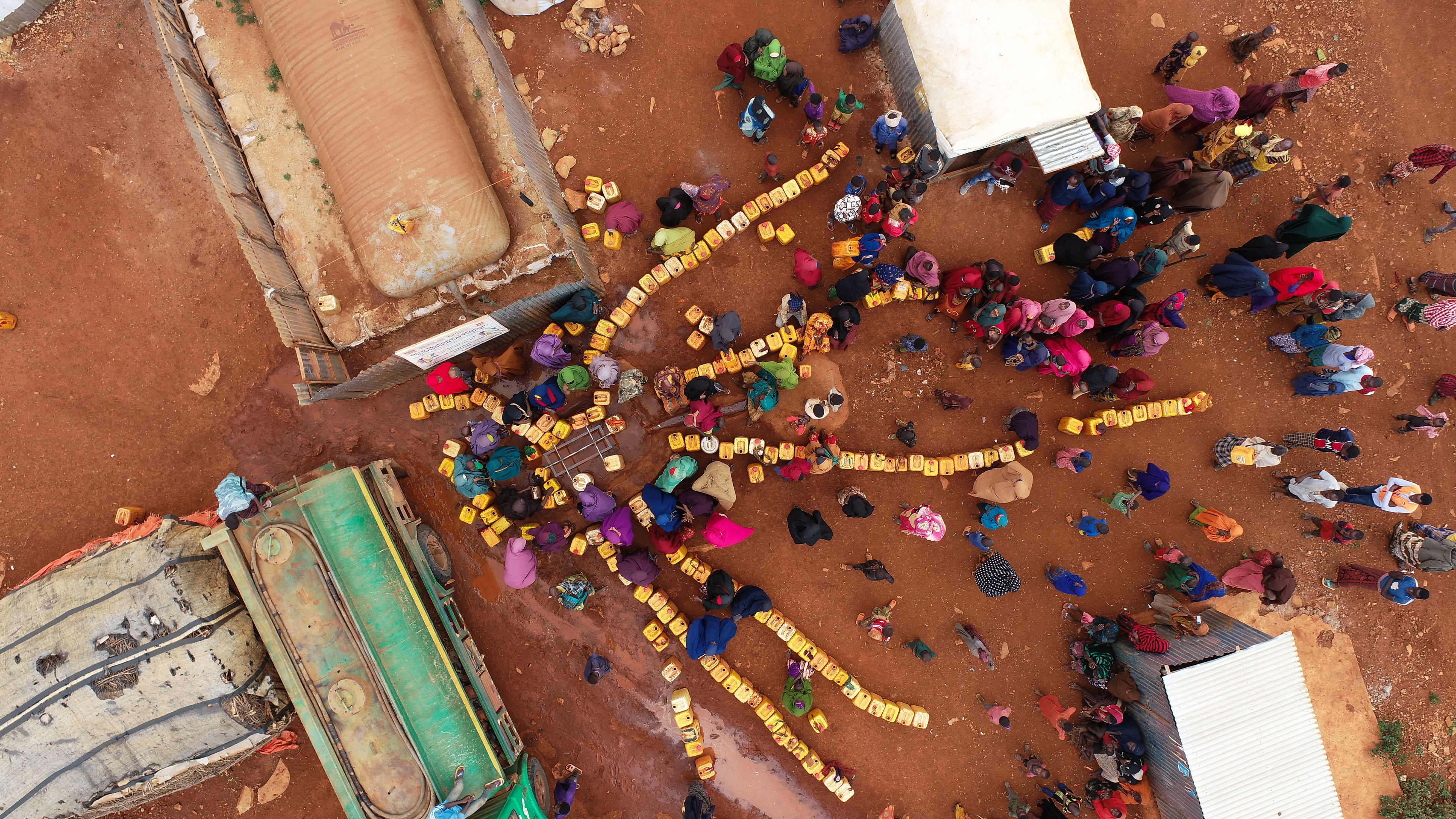
Malawi: Cyclone Freddy triggers unprecedented displacement
Tropical cyclone Freddy was one of the longest-lasting recorded worldwide. It formed in the Indian Ocean on 5 February and dissipated in Malawi on 14 March, affecting six countries and territories across south-eastern Africa.82, 83, 84 After making landfall in Madagascar and Mozambique, Freddy hit southern Malawi as a category 4-equivalent storm, severely affecting the districts of Blantyre, Chikwawa and Nsanje and triggering more than 659,000 internal displacements, the highest figure ever for the country.
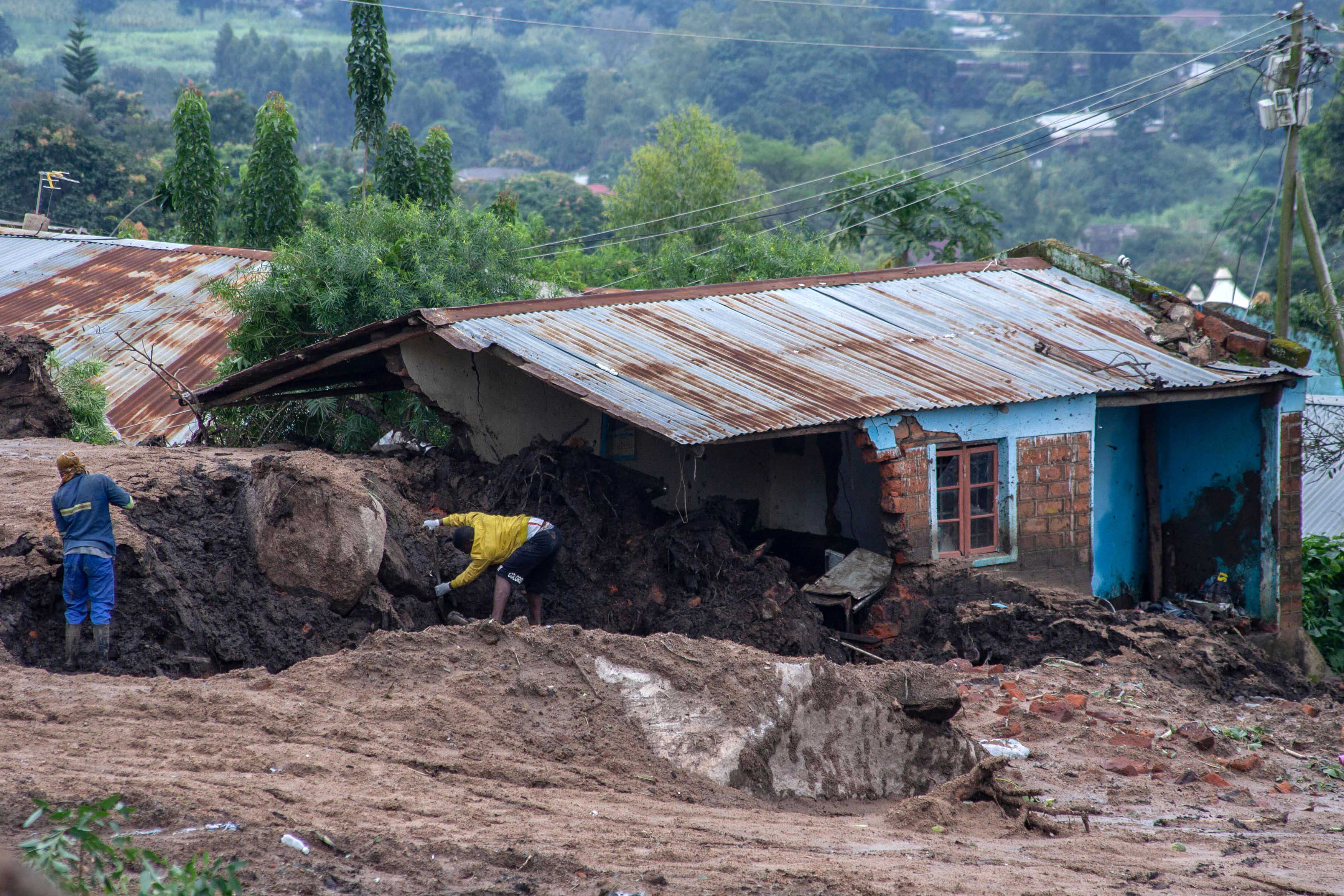
Residents work to find loved ones in the aftermath of a landslide caused by Tropical Cyclone Freddy when it made landfall in Malawi in March. The cyclone affected six countries, triggering more than 659,000 displacements in Malawi alone. © AMOS GUMULIRA/AFP/Getty Images
Residents work to find loved ones in the aftermath of a landslide caused by Tropical Cyclone Freddy when it made landfall in Malawi in March. The cyclone affected six countries, triggering more than 659,000 displacements in Malawi alone. © AMOS GUMULIRA/AFP/Getty Images
The cyclone caused floods, landslides and mudslides, which were aggravated by deforestation and land degradation. Homes were severely damaged and destroyed, forcing authorities to quickly set up displacement camps. More than three-quarters had been decommissioned by the end of June and some people had been able to go back to their homes, but information on returns is limited.85
The storm also damaged basic infrastructure and shut down markets as well as education and health facilities, increasing the risk of waterborne diseases in a country already struggling with its deadliest cholera outbreak in 60 years.86, 87 Food insecurity also became a challenge, particularly in the worst affected districts of Chikwawa and Nsanje.88
Freddy was the third deadliest cyclone ever recorded in the southern hemisphere, just after cyclone Idai which hit the same countries four years ago. 89 A month after Freddy, Malawi adapted its disaster risk management system, which was geared toward reducing flood risk, to reflect the fact that other hazards including storms and landslides have become the leading causes of mortality and displacement. It also updated its Disaster Risk Management Act to put more emphasis on early warning, prevention and risk reduction, including the importance of conducting pre-emptive evacuations and developing climate adaptation strategies.90, 91 These initiatives are essential, considering that the frequency and intensity of cyclones are projected to increase in southern Africa.92
Background image: Cyclone Freddy caused floods, landslides and mudlsides across Malawi. © JACK MCBRAMS/AFP/Getty Images
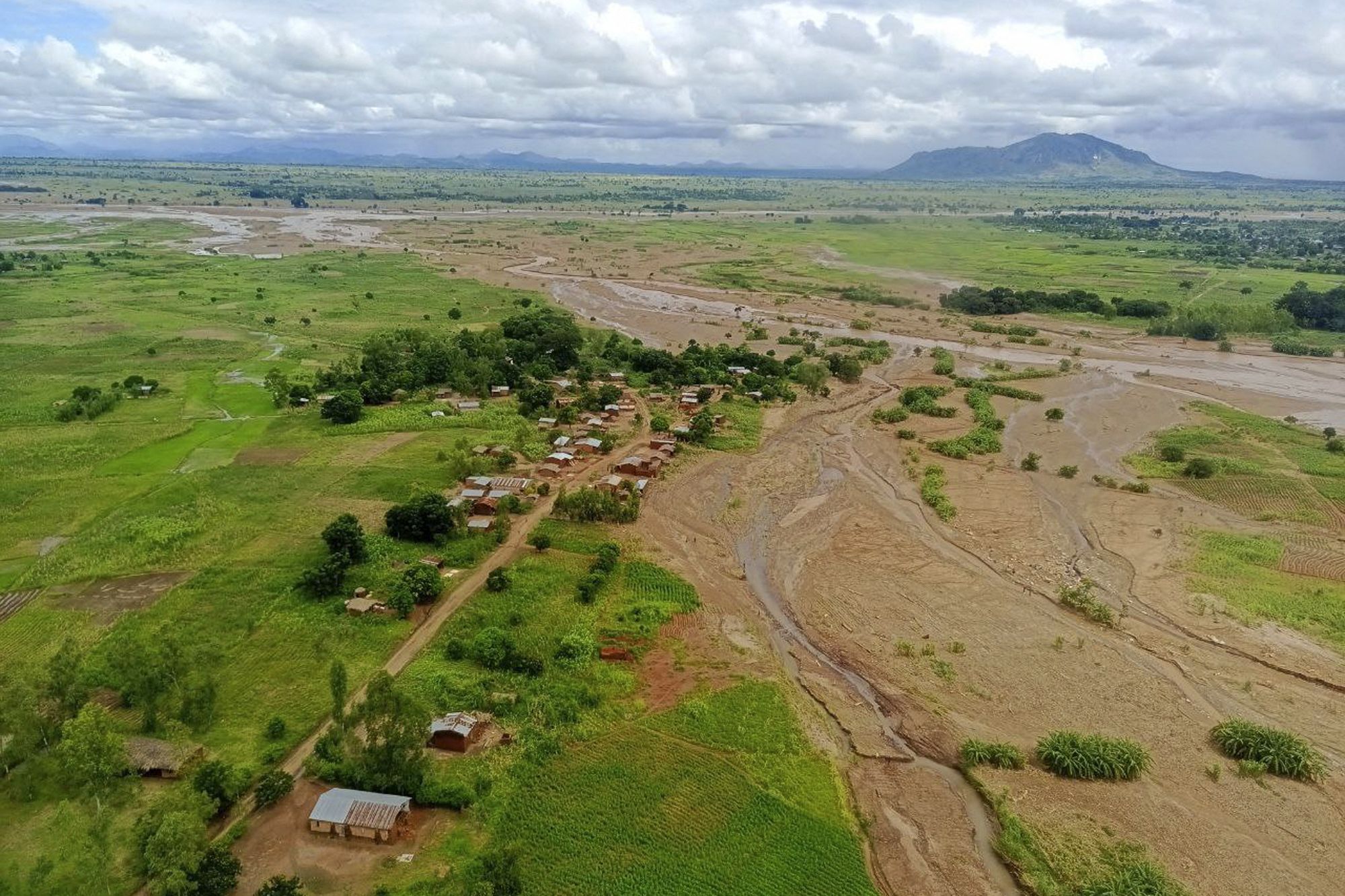
Haiti: Escalating criminal violence and floods fuel displacement
Criminal violence triggered around 91,000 internal displacements across Haiti between January and June 2023, more than 85 per cent of the total figure for 2022, which was already the highest since data became available for the country in 2019.93, 94 Most movements took place in and around the metropolitan area of the capital, Port-au-Prince, 80 per cent of which is controlled by criminal gangs.95, 96 As they expanded their presence in the departments of Ouest, Centre and Artibonite, displacement was also recorded there.97, 98, 99
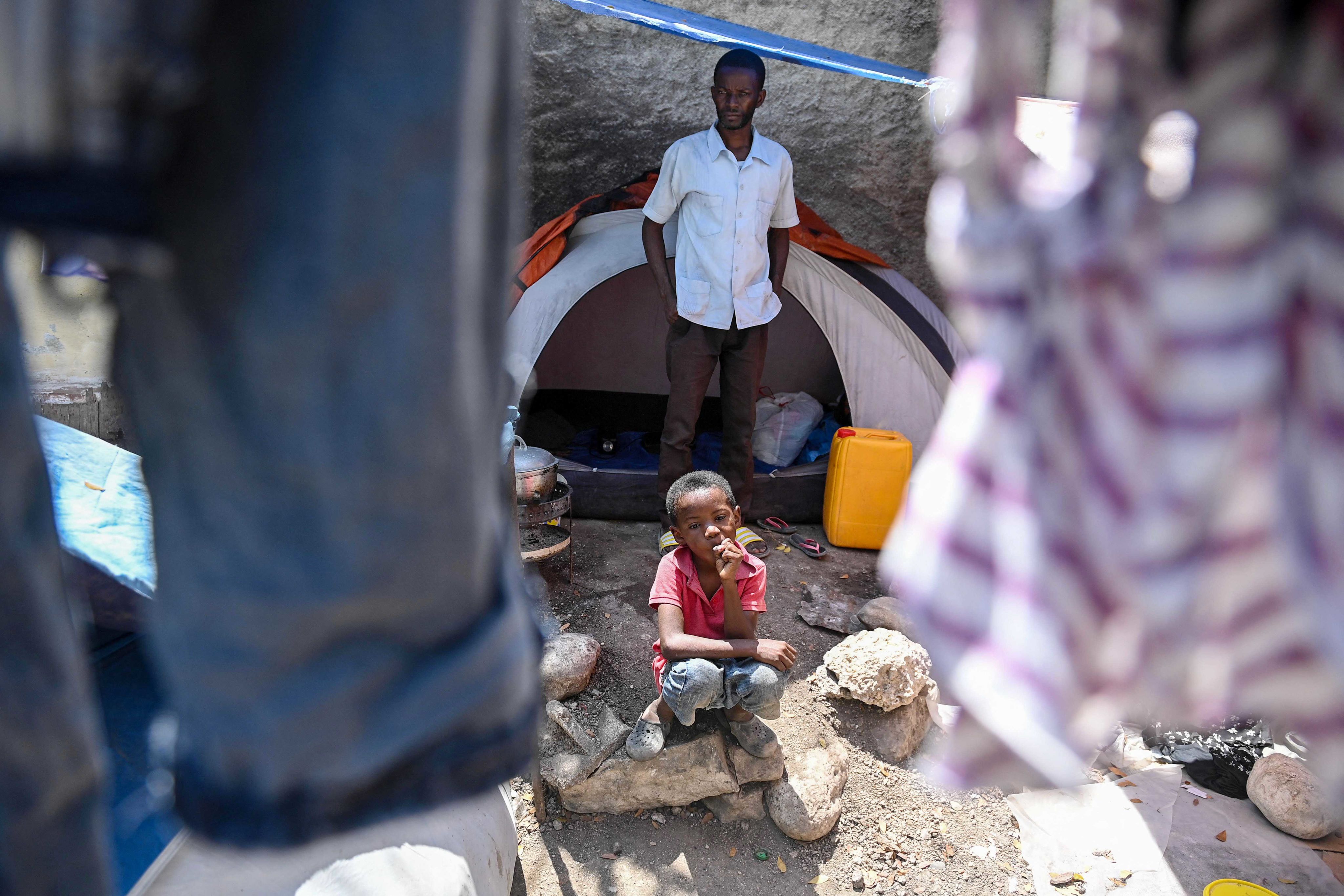
A school principal and church pastor stands in front of his tent with his son in Port-au-Prince, Haiti. Many people fleeing violence in the city are living in makeshift camps with little to no access to basic services. © RICHARD PIERRIN/AFP/Getty Images
A school principal and church pastor stands in front of his tent with his son in Port-au-Prince, Haiti. Many people fleeing violence in the city are living in makeshift camps with little to no access to basic services. © RICHARD PIERRIN/AFP/Getty Images
Vigilante groups formed to fight back against the gangs during the first half of the year, and their activities helped to fuel displacement.100, 101, 102, 103 Against the backdrop of increasing violence, little progress was made in providing international support for the efforts of the national police to re-establish security.104
In recent months, the government has been closing down displacement sites, where protection challenges, including GBV, have been widely reported, and declared it will not set up new ones to host those fleeing violence.105, 106, 107 This leaves many with no option but to shelter in makeshift camps or with host families with little to no access to basic services, which also puts them at risk of cholera and other waterborne diseases.108, 109, 110, 111
Disasters have made the humanitarian situation more complex still. Heavy rains caused floods and landslides in the first days of June, particularly in Ouest department and Port-au-Prince.112 Evacuations organised by the authorities accounted for many of the nearly 10,000 movements recorded.113, 114 The 2023 floods triggered more displacements than any previous flooding in the country.
Background image: A woman carries her belongings while fleeing violence in Port-au-Prince, Haiti. © RICHARD PIERRIN/AFP/Getty Images)
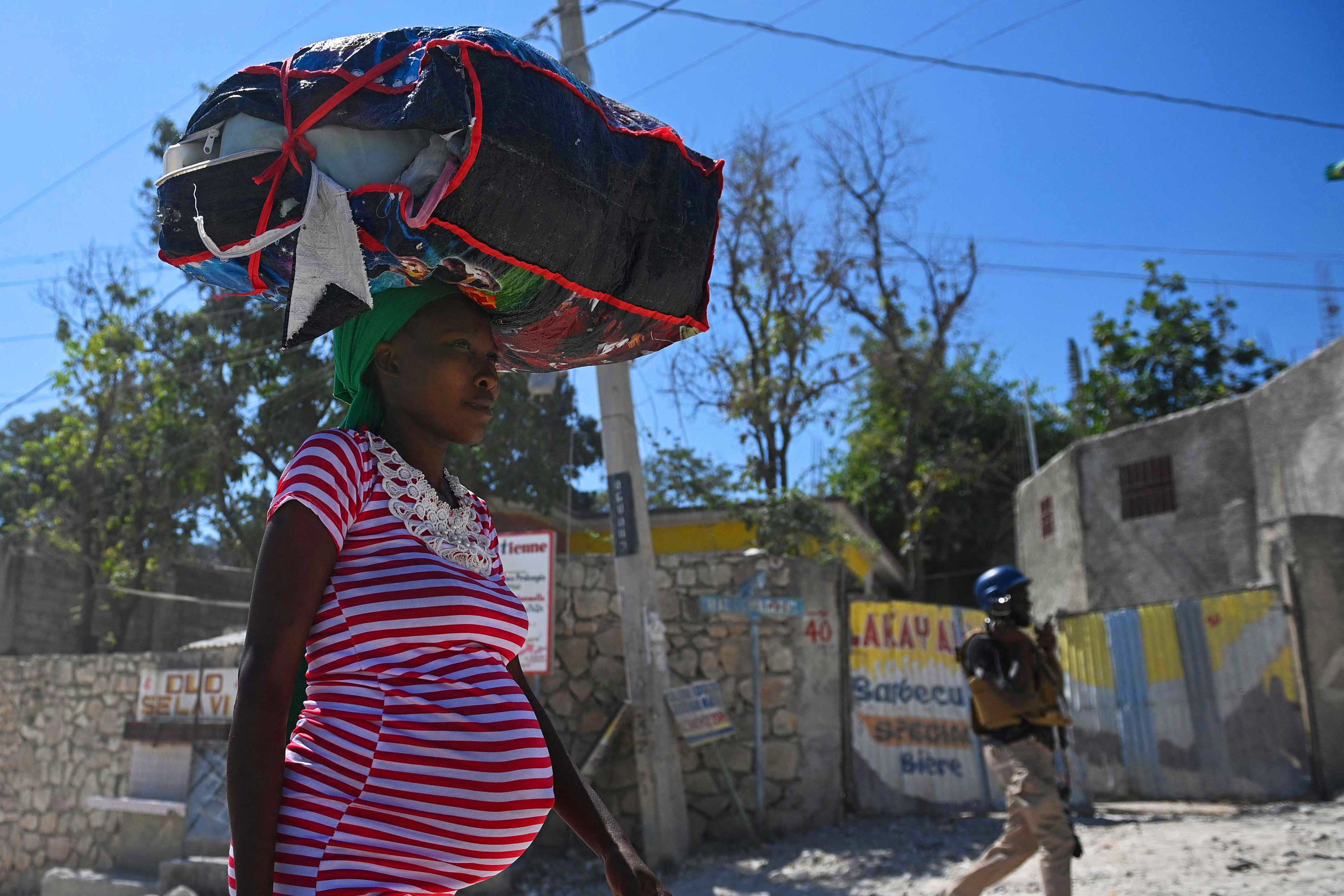
India: Intercommunal violence in Manipur triggers displacement
Intercommunal tensions in Manipur led to protests on 3 May that turned violent, becoming one of the deadliest confrontations in the north-eastern state’s recent history. The violence broke out in Churachandpur district and spread to Imphal East, Imphal West, Bishnupur, Tengnupal and Kangpokipi, triggering around 66,000 internal displacements as of 30 June. This was the highest figure for displacement associated with conflict and violence in the country since 2018 when violence and displacement took place in Indian-controlled Kashmir.115, 116
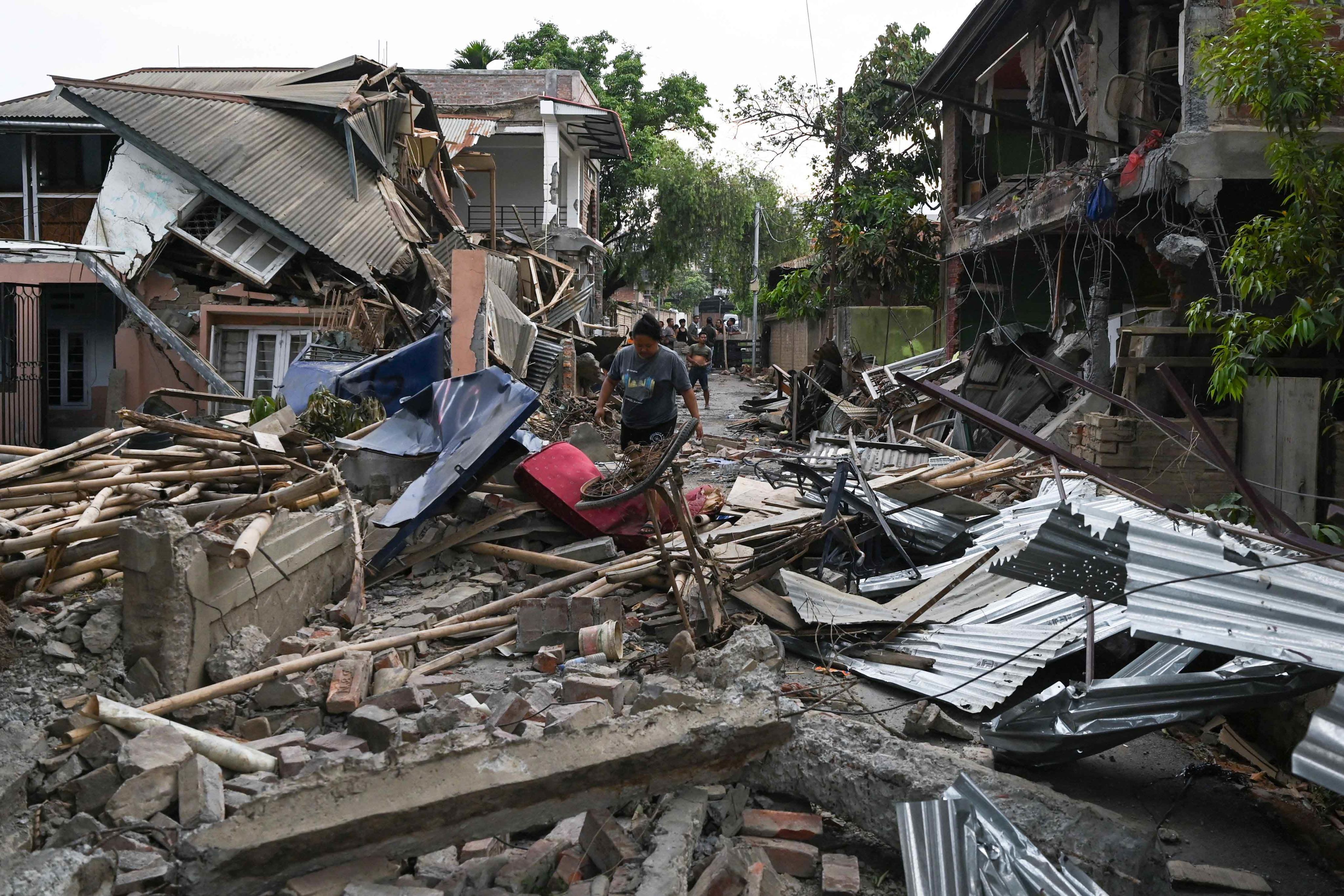
A woman in Khumujamba, India walks through the wreckage of buildings destroyed in the violence that spread through the state of Manipur in May. This triggered around 66,000 displacements, and many of those forced to flee were still displaced at the end of June. © Arun SANKAR/AFP/Getty Images
A woman in Khumujamba, India walks through the wreckage of buildings destroyed in the violence that spread through the state of Manipur in May. This triggered around 66,000 displacements, and many of those forced to flee were still displaced at the end of June. © Arun SANKAR/AFP/Getty Images
The violence in Manipur has an ethnic dimension and is rooted in the state’s historical social, economic and political structures. Disputes over land distribution and rights are also underlying drivers.117, 118, 119, 120 The Indian government received a formal petition at the end of March to recognise the Meitei community as a scheduled tribe, an official status designed to protect minorities from socioeconomic and political marginalisation.121, 122 The request was met with resistance from other local scheduled tribes, including the Kukis, who argue their economic, political and social disadvantages are unresolved.123, 124
As the violence escalated, the central government imposed curfews, shut down the internet and sent in the security forces.125, 126 It also set up relief camps to assist those displaced.127 More than three-quarters of the displacements recorded were within Manipur, but almost a fifth were to the neighbouring state of Mizoram and smaller numbers to Nagaland and Assam states.128 Some people also fled across the border to Myanmar.129 The central government also established a peace committee for Manipur chaired by the state governor, but the initiative has been hampered by disagreements about its composition.130
Most of those who fled the violence were still displaced as of 30 June.
Background image: Charred remains of a residence in Imphal, India, set ablaze by a mob during intercommunal violence in the state of Manipur. © Anuwar Hazarika/NurPhoto via Getty Images
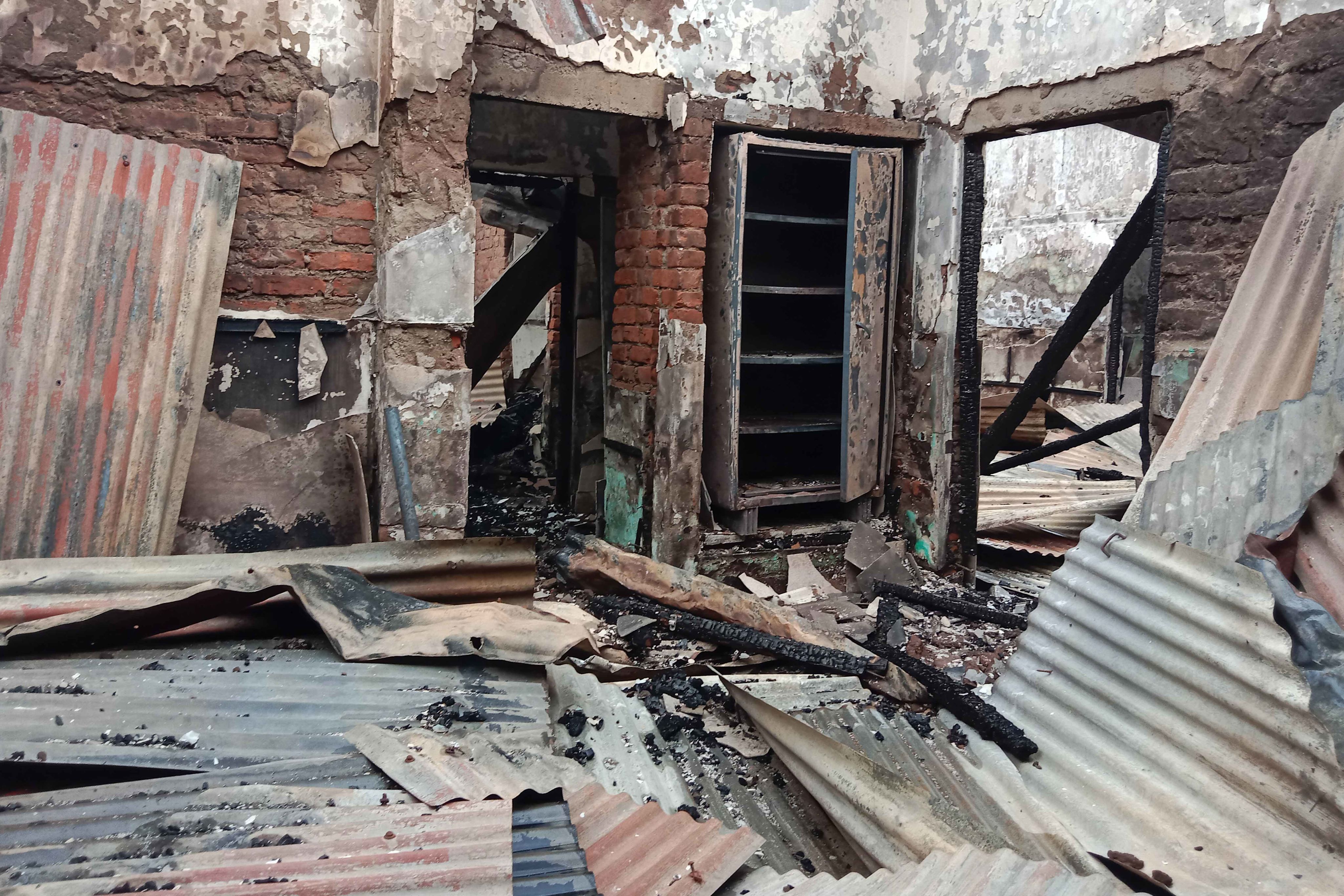
Vanuatu: back-to-back disasters
The Pacific island state of Vanuatu experienced four back-to-back disasters in just three days at the beginning of March. Cyclone Judy, a category 4-equivalent storm hit several islands on the first day of the month, including Efate, home to the capital Port Vila. The storm was followed the next day by two earthquakes of magnitude 6.5 and 5.4 with epicentres in the northern province of Sanma, and cyclone Kevin, another category 4-equivalent storm brought heavy rain, storm surges and winds as high as 157 km/h on 3 March.131
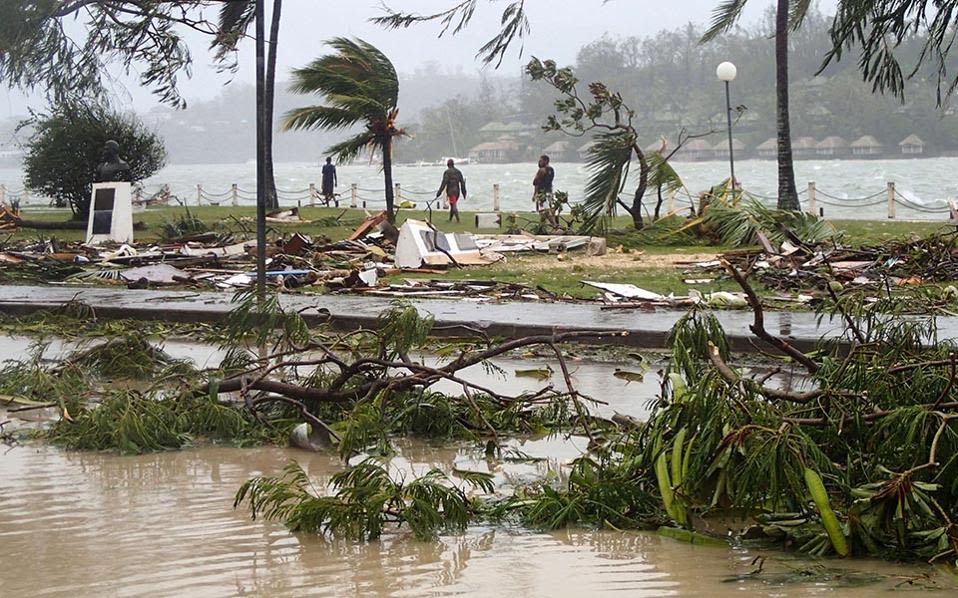
Residents inspecting damage after Cyclone Judy made landfall in Efate, Vanuatu. © Tom Perry/CARE
Residents inspecting damage after Cyclone Judy made landfall in Efate, Vanuatu. © Tom Perry/CARE
Between them, the disasters triggered around 5,200 displacements, which should be considered a conservative estimate given that it is based on people who sought shelter in evacuation centres and with host families. The number of homes destroyed points to a higher figure.132
The southern provinces of Tafea and Shefa were worst affected, particularly by the impacts of Judy and Kevin. People in Shefa on Efate took refuge in 51 evacuation centres and with host families.133, 134 As they returned, many did so to disaster-prone areas and rebuilt their homes with materials that are unlikely to withstand the impacts of future events of similar magnitude.135 Female-headed households faced specific challenges, because they tend to not own the land they live on and to have difficulty in accessing the finances and labour to rebuild.136
The impacts of Vanuatu’s back-to-back disasters were significant, but the government was better prepared to respond thanks to lessons learnt from previous events including cyclones Pam in 2015 and Harold in 2018.137, 138 It activated early warning systems before the two storms made landfall and declared a nationwide state of emergency on 5 March. With international support, it identified priority areas to carry out rapid needs assessments and activated clusters to attend those in need of food, emergency shelter and assistance.139, 140, 141 An early recovery plan was developed to identify sectoral needs and priorities and ensure the transition from response to recovery.142
Background image: Children playing in a school damaged by Cyclone Pam in 2019 and which was later repaired. Lessons learned by the government after previous disasters left it better prepared to manage the impacts from two category 4 storms and two major earthquakes that hit the island nation in only four days in March. © Mario Tama/Getty Images
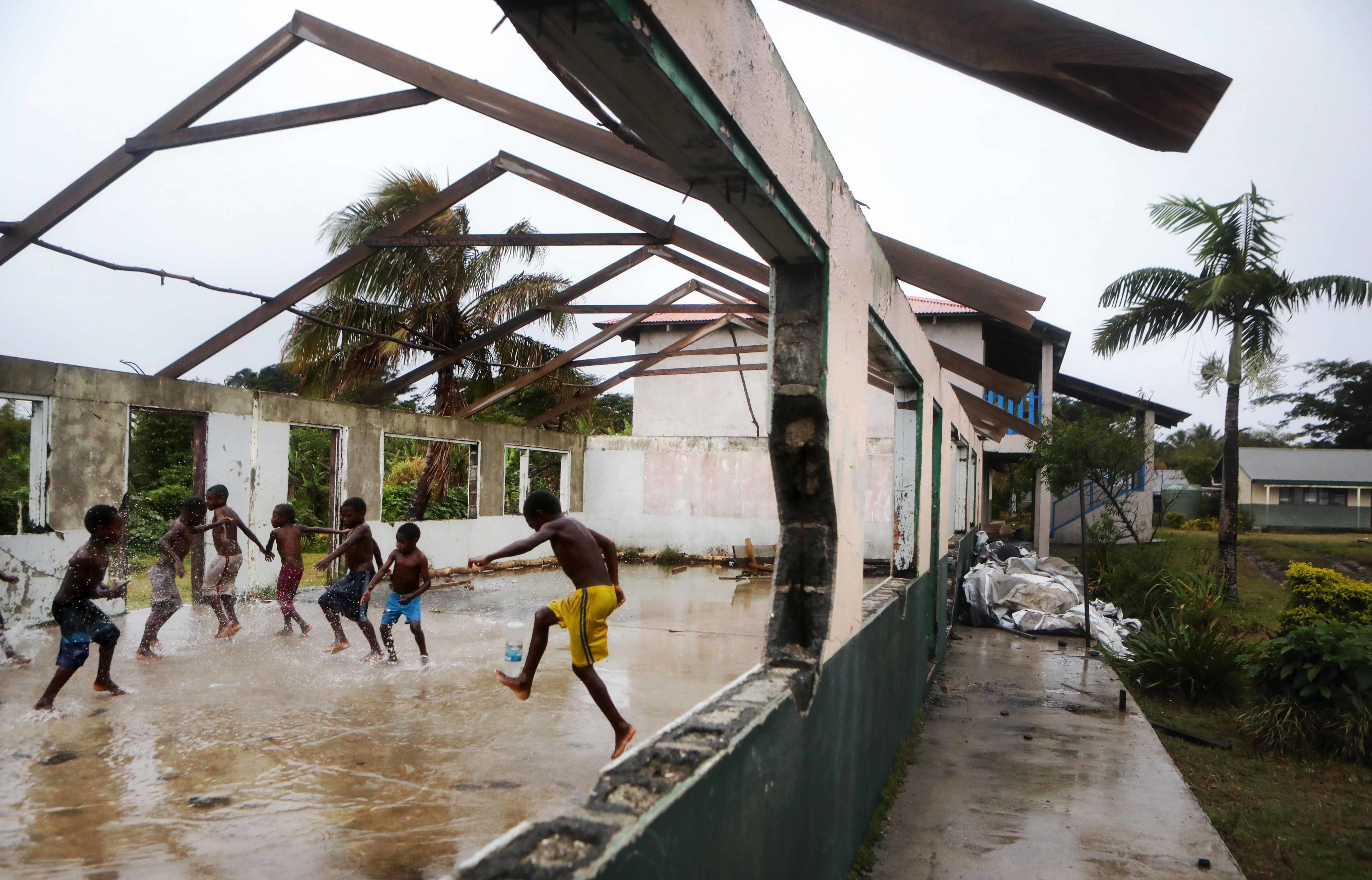
Our data
The figures presented here are already touching record levels for many countries, but only represent partial estimates because of the different reporting timeframes and the geographical coverage of the different sources. We will continue to identify new sources of data on internal displacement triggered by conflict, violence and disasters, triangulate them and collaborate with partners and data producers around the world to improve and verify our estimates. As always, IDMC’s final verified figures of internal displacement for 2023 will be presented in our 2024 Global Report on Internal Displacement which will be released in May 2024.
Cover image: People waiting for news of their relatives around a campfire amidst the rubble of collapsed buildings in Hatay, Türkiye after earthquakes caused widespread damage in the country and neighboring Syria in February. © BULENT KILIC/AFP/Getty Images
Follow our daily updates on these and more displacement situations via our internal displacement updates.
To learn more about how we measure internal displacement and our two metrics, watch a short animation here.
